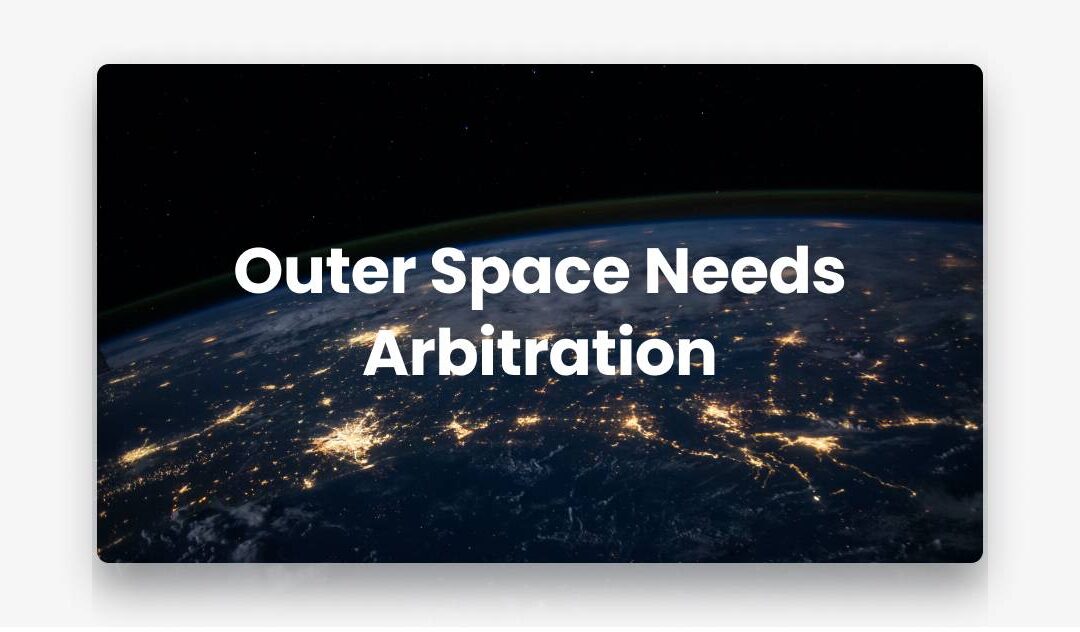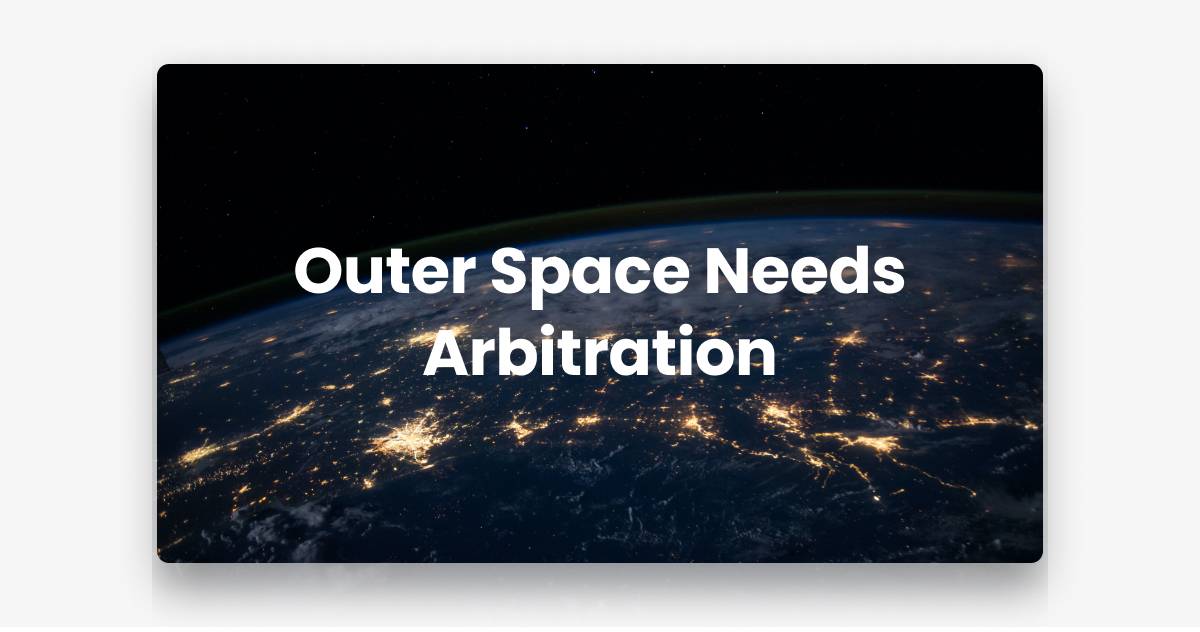Investor-State Space Arbitration Rules By Ben Love and Sagar GuptaAs foreshadowed in previous blog...

Investment Protection of Space Assets

The first major international space treaty, the 1966 Treaty on Principles Governing the Activities of States in the Exploration and Use of Outer Space, including the Moon and Other Celestial Bodies (the “Outer Space Treaty”) recognizes that “the exploration and use of outer space… shall be the province of all mankind” (Article I). In the decades following the Outer Space Treaty, international investment arbitration has emerged as a powerful tool to check State conduct towards foreign investors in industries such as infrastructure, energy, financial services, and technology.
More than half a century later, the increasing involvement of private commercial parties in outer space activities is testing the boundaries of investment arbitration and international space law. Today, private actors are investing significant financial and technical resources in the space sector, including telecommunications satellite services, space tourism, and resource exploration and mining.
Although the traditional methods of inter-State dispute settlement remain cumbersome, foreign investors in the space sector may be able to seek investment protections under bilateral investment treaties (“BITs”) and other international investment protection agreements. The application of investment protections in their current form to space assets raises issues of first impression, but arbitral practice has shown that investment arbitration may be used by countries to incentivise and regulate investor behaviour and may find application in commercial space activities.
With this in mind, we will explore various themes on the challenges and opportunities for investment arbitration in the space sector over three blog posts. In the first blog post of this series, we look at the application of the investment protection regime in relation to space assets and recent investment treaty practice in the space sector.
Are Space Assets “Investments”?
To exercise jurisdiction over a claim, an investor-State tribunal must determine whether there is a protected “investment” made by a foreign “investor”. Most investment treaties contain an “asset-based definition” of “investment” which includes a non-exhaustive list of protected assets. These often include movable and immovable property, shares and financial instruments, intellectual property rights, claims to money, licenses, and concessions, among other types of assets. Tribunals have also sometimes held that investments need to satisfy certain other characteristics such as duration, assumption of risk, commitment of capital, and contribution to the economic development of the host State.
Given the highly complex nature of commercial space activities, significant contribution of capital and risk is typically involved. Further, commercial space activities such as satellite telecommunications are often long-term projects requiring investment over a considerable period. Commercial space activity also often furthers the host State’s own objectives and goals of economic development. Key types of space assets that might qualify as “investments” include satellites and other equipment, contractual rights and licences, and participation in licensed entities operating in the host State.
Territoriality of Space-Based Assets
Investment treaties often require investors to demonstrate that there is an “investment” in the “territory of the host State.” The analysis for tangible assets is usually straightforward with territoriality being determined by the situs of that asset. In investor-State space arbitrations, however, with physical assets such as mining equipment or satellites operating in outer space, challenges with satisfying that territoriality requirement are not unexpected.
An added layer of complexity is the international space law regime. Notwithstanding that outer space “is not subject to national appropriation by claim of sovereignty” (Article II, Outer Space Treaty), States retain “jurisdiction and control” over any object launched into outer space on their registry (Article VIII, Outer Space Treaty). If outer space is not subject to sovereignty and territoriality claims, respondent States may take the position that the space activities are outside of the territory of the host State (even if such activities are within the host States’ control). Whilst the interpretation of the treaty text is likely to turn on the wording of the specific treaty, investors may in turn attempt to advance the argument that “territory” for the purposes of BITs would include any physical space within the host State’s jurisdiction or control. How a tribunal would receive such an argument remains to be seen.
Investors may seek to rely on intangible assets (such as licences and contractual rights for commercial space activities obtained under the host States’ licensing regimes) as qualifying investments. In doing so, the mandate of the 1974 Convention on Registration of Objects Launched into Outer Space (the “Registration Convention”) requiring member States to set up registries of space objects might offer some guidance.
An added challenge for investor-State space arbitration is that whilst the Registration Convention requires the “launching State” to register a space object launched from its territory, most space projects involve multiple jurisdictions – for instance, in the telecommunications sector, a satellite may be launched, controlled, and provide services to three different countries. Given this feature of modern space investment, the assessment of territoriality would appear to require a case-specific assessment to determine the degree of territorial nexus with the relevant State.
Investor-State Cases in the Space Sector
Notwithstanding the scant number of investment arbitrations in the space sector, there are important lessons that emerge from recent practice. Perhaps unsurprisingly, the publicly available decisions thus far concern claims by satellite companies operating in the telecommunications industry.
The Devas-Antrix saga which began in 2011 and yielded multiple arbitration and litigation proceedings across jurisdictions, gave rise to one of the first investor-State space cases. The shareholders of Devas Multimedia Private Limited (“Devas”) brought claims against India under the India-Germany BIT (Deutsche Telekom AG v. The Republic of India, PCA Case No. 2014-10) and the India-Mauritius BIT (CC/Devas (Mauritius) Ltd., and others v. The Republic of India, PCA Case No. 2013-09) for the alleged expropriation of their investments and breach of other treaty standards.
The underlying contractual breach alleged in both cases arose from the same contract: Devas entered into an agreement for the lease of space segment capacity on two Indian satellites with a state-owned company, Antrix Corporation Ltd. (“Antrix”) in 2005. Following the decision of India’s Cabinet Committee on Security to reserve the S-band capacity for defence and other strategic use, Antrix terminated the lease agreement. This termination gave rise to an ICC international commercial arbitration and multiple BIT arbitrations. Notably, the ICC award which required Antrix to pay Devas over US$500 million in damages was recently set aside by the Delhi High Court on grounds of patent illegality and violation of Indian public policy.
The BIT cases from the Devas-Antrix saga addressed the following issues of note:
- Indirect investments: Both tribunals interpreted the unqualified definition in the BITs to include indirect investments. Resultingly, the Claimants’ “shares in, stock and debentures of” and “any other form of participation” in Devas and their indirect partial ownership of Devas’ business assets were “investments”.
- Essential Security Interest (“ESI”): Even though both arbitrations arose from the same set of facts, the tribunals reached opposite conclusions on India’s ESI defence. The CC/Devas tribunal accepted India’s ESI defence holding the termination of the lease agreement to be “absolutely necessary” and “unavoidable” as India was in “genuine need” of the spectrum. The Deutsche Telekom tribunal, by contrast, concluded that there was no connection between India’s ESI and Antrix’s decision to cancel the lease agreement.
The most recent investor-State decision in the space sector stems from an ICSID arbitration between the French satellite operator Eutelsat (formerly an intergovernmental organisation) and Mexico (Eutelsat S.A. v. United Mexican States, ICSID Case No. ARB/AF/17/2). The Eutelsat arbitration, filed under the France-Mexico BIT, concerned claims arising out of alleged discriminatory regulations requiring spectrum allocation for government use. Whilst foreign licensees were required to allocate 8MHz of their capacity for government use, Eutelsat’s Mexican subsidiary was required to allocate 362MHz, which put it at a disadvantage according to Eutelsat. The Eutelsat award is not public. In 2021, however, it was reported that the tribunal had dismissed Eutelsat’s claim for breach of the BIT’s fair and equitable treatment standard.
It has been argued that international investment arbitration can be used to incentivize commercial space activities, and even be used to address space collisions and space debris. Whilst this remains an open question, foreign investors in the space sector may still consider turning to investment treaties to protect their investments.
In the next blog post, we will examine applicable law issues in space arbitration proceedings. Given the overlap between public international law instruments such as the Outer Space Treaty, soft law instruments including UN General Assembly resolutions, national legal regimes, and private contracts, choice of law and applicable law issues in these disputes are not always straightforward.
For those interested in investor-State space arbitration, the Space Arbitration Association held a panel discussion on “Can Space Arbitration Protect Space Investments?” on Friday, 2 September 2022. You can view the panel discussion online here.
You might also like
Investor-State Space Arbitration Rules
Inter-State Space Arbitration
Inter-State Space Arbitration By Luc ColinOn 26 April 2022, the Space Arbitration Association...
Private Parties in Space Law
Private Parties in Space Law By Luca ErhartThere needs to be room for private parties in...










